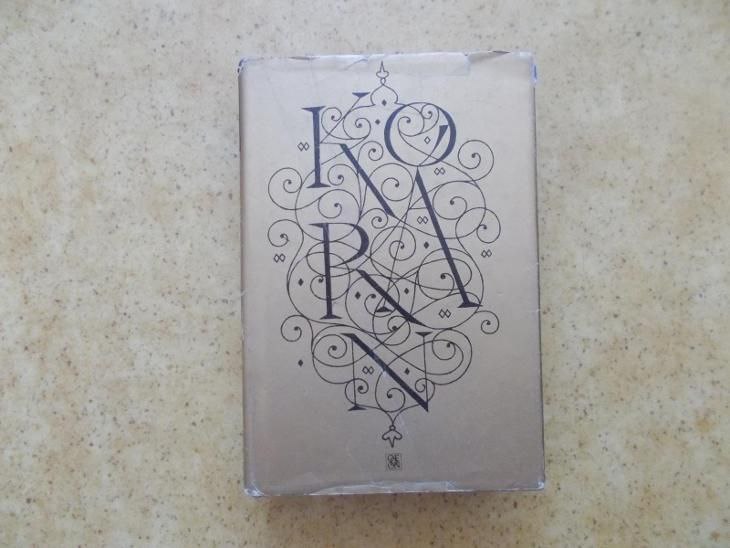Can a Qur’an translation be both ‘Muslim’ and ‘Orientalist’ at the same time? The history of Ivan Hrbek’s translation of the Qur’an into Czech is an interesting case that provides some useful insights.
Although the number of Muslims living in the Czech Republic has never exceeded 0.1% of the overall population (of around ten million), four complete translations of the Qur’an into Czech were published in the twentieth century (including one Ahmadi translation). The one that is the most popular and most widely accepted by the Muslim community was authored by a Czech scholar of Arabic and Islamic Studies, Dr Ivan Hrbek (1923–1993). Hrbek graduated from Charles University in Prague, and went on to became a member of staff at the Oriental Institute of Czechoslovak Academy of Sciences. He was primarily interested in classical Arabic literature, but also published a lot of material on the medieval geography, history and culture of West Africa. He also was known to the local Muslim circles, under his Islamic name Ahmad, as the President of the Muslim Religious Community for Czechozlovakia in the years immediately after the end of World War 2, between 1945 and 1955. After working for around 20 years on his translation of the Qur’an, Ivan Hrbek finally published it with the Odeon publishing house in Prague in 1972. According to some sources, almost all of the 20,000 copies from this initial print run were sold in just one week; despite this it was not reprinted until 1991.
Hrbek opted to follow the so-called ‘chronological’ order of the suras in his initial translation, but this was changed by later Muslim editors to the standard sura order, and a further edition, printed in 2000, saw the addition of commentary drawn from the English translation by Abdullah Yusuf Ali. The first edition of Hrbek’s translation incorporated the verse numbering systems used by both the Flügel edition and the Cairo musḥaf, and hence had ‘double-numbering’; however, later editions contained only the standard Cairo verse numbering. The 2006 edition also incorporated parallel Arabic text for the first time.
A closer look at the first edition of Hrbek’s translation reveals its background in twentieth-century European oriental studies. The translation is prefaced by a long introductory statement (of more than 100 pages) which provides the historical background of the Qur’an, as do additional commentaries placed at the very end of the work. When discussing his approach to the interpretation of the Qur’anic text, Hrbek confirmed that he consulted two earlier translations into Czech (by Alois Nykl and Ignác Vesely), the Italian translation by Alessandro Bausani, Richard Bell’s English translation, Régis Blachère’s French translation and, finally, Ignaty Krachkovsky’s Russian translation. The latter probably had the biggest influence on Hrbek’s Czech translation, not only because of the closeness of the Czech and Russian languages, but also due to the grammatical style of Krachkovsky’s Russian text, which sometimes veered into being over-literal. When comparing Hrbek’s Czech rendition with the original Arabic, we see a typical word-for-word technique of interpretation; this is generally possible in Slavic languages (in which word order is quite flexible), but sometimes makes the text read in a somewhat unusual way. For example, in his translation of Q. 2:7, ‘khatama ’Llāhu ʿalā qulūbihim wa-ʿalā samʿihim wa-ʿalā abṣārihim gishāwatun wa-lahum ʿadhābun ʿaẓīm’, Hrbek writes: ‘Bůh srdce jejich i sluch jejich zapečetil a přes oči jejich clonu poloţil a pro ně je určen trest hrozný’ (lit. ‘God sealed their hearts and their ears, and laid a veil over their eyes, and there was a terrible punishment for them’), with almost every Czech word here placed in the same order as the Arabic original. Another instance of literal wording can be seen in his translation of ‘… nādī rabbihi nidā’ khafiya’ (lit. ‘he called his Lord with the hidden call’) as ‘zavolal k Pánu svému voláním tajným’. In contrast to most Muslim-authored translations Hrbek makes very little recourse to tafsīrs, but he does use extra-Qur’anic material in some places: for example, the title of Sūrah 103 (al-ʿAṣr) is translated as ‘Osud’ (‘Fate’, ‘Destiny’), in line with the way it is interpreted in many exegetical works. A thorough reading of some suras also reveals the use of extra-Qur’anic materials in the text of some verses: for example, in Q. 43:12, ‘al-anʿam’ is interpreted as ‘velbloudy’ (‘camels’), while the Arabic word has the broader meaning of ‘animals’; for the expression ‘law lā an yakūna ’l-nās ummatan wāḥida’(‘people might become one community’) in Q.43:33 Ivan Hrbek adds the word ‘nevěřících’ (‘unbelievers’) to his ‘stali jediným národem’, a change to the literal reading of the Arabic that also corresponds to the standard tafsīr reading of this verse. To give another bit of context, drawn from just ten verses before, Hrbek translates Q. 43:22 (‘inna wajadna ‘abbā’na ‘alā umma-tin’ (‘we found our forefathers [belonging] to this community’) as ‘Nalezli jsme otce své v jistém učení’ (‘We found our fathers in a certain doctrine’). Some of the commentary added in by Hrbek is especially useful in understanding and contextualizing the verses in question, and for Czech readers in the mid-1970s and 1980s provided one of a limited number of opportunities to access the Qur’an.
What seems to be rather unique in the case of Hrbek’s translation is that it has not been substituted by any other interpretation during the almost 50 years since its initial publication. Some later corrections and additions (such as the addition of commentary from Abdallah Yusuf Ali’s work) have made this translation more ‘Muslim’ in style, but it is still widely used in academic writings on Islam, comparative religion, and other topics of research. The fact that it has been published in six editions, with the latest appearing in 2012, along with its wide availability on various Muslim web-sites, mean that this work is still the most important contribution to Qur’anic studies in the Czech language.
Mykhaylo Yakubovych



